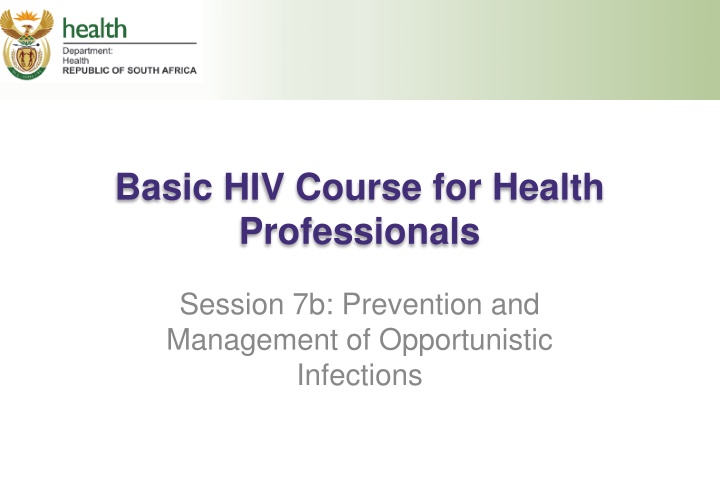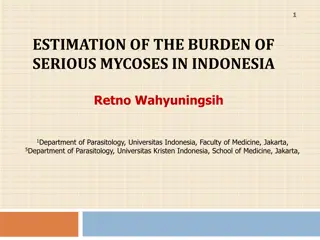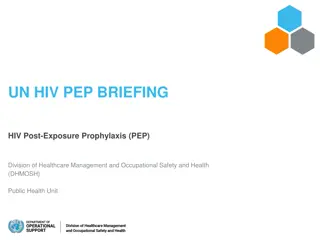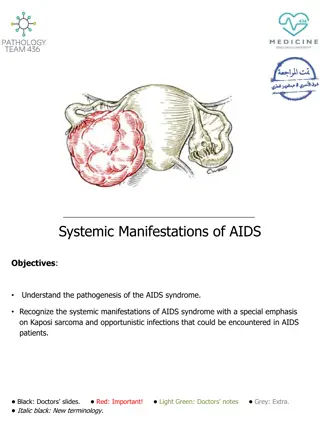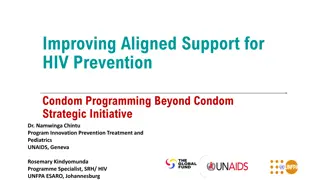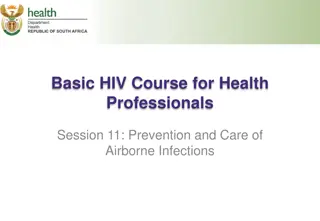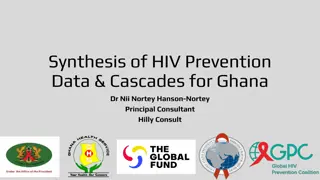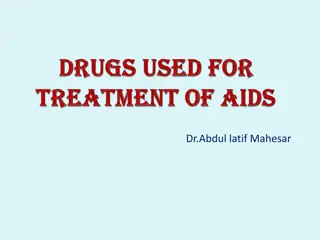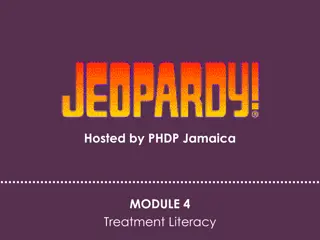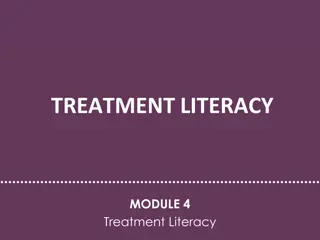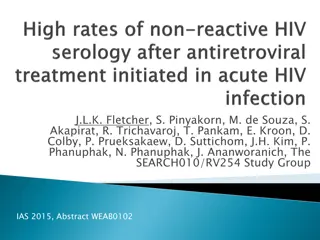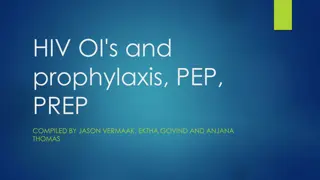Prevention and Management of Opportunistic Infections in HIV
This session covers common opportunistic infections in HIV patients, their prevention, and management. Topics include Pneumocystis pneumonia, recommended prophylaxis and treatment, referral criteria, and more.
Download Presentation

Please find below an Image/Link to download the presentation.
The content on the website is provided AS IS for your information and personal use only. It may not be sold, licensed, or shared on other websites without obtaining consent from the author.If you encounter any issues during the download, it is possible that the publisher has removed the file from their server.
You are allowed to download the files provided on this website for personal or commercial use, subject to the condition that they are used lawfully. All files are the property of their respective owners.
The content on the website is provided AS IS for your information and personal use only. It may not be sold, licensed, or shared on other websites without obtaining consent from the author.
E N D
Presentation Transcript
Basic HIV Course for Health Professionals Session 7b: Prevention and Management of Opportunistic Infections
Learning Objectives By the end of this session participants should be able to: Describe common opportunistic infections Discuss the prevention of opportunistic infections Explain the management of common opportunistic infections
Pneumocystis pneumonia (PCP) What are The Most Common Opportunistic Infections? Cryptococcal meningitis Tuberculosis (TB)
Pneumocystis Pneumonia (PCP) Pneumocystis jiroveci pneumonia (PCP) is WHO stage 4 and requires ART fast tracking Commonly occurs when a person has a CD4 count below 200 Mainly a clinical diagnosis Signs and symptoms include fever, cough, tachypnoea, and dyspnoea.
Recommended Prophylaxis for PCP Co-trimoxazole prophylaxis markedly reduces hospitalization and mortality and provides protection against: Pneumocystis pneumonia (PCP) Toxoplasmosis malaria and many other bacterial infections
Recommended Treatment for PCP Adults: Co-trimoxazole, oral, 6 hourly for 3 weeks Recommended treatment for PCP in Adults Approx. weight kg Use one of the following tablets <40 kg >40 56 kg >56 kg 80/400 mg 2 tablets 3 tablets 4 tablets 160/800 mg 1 tablet 1 tablets 2 tablets
Referral All children Breathing rate > 24 breaths/minute Shortness of breath with mild effort Cyanosed patients
Secondary Co-trimoxazole Prophylaxis Use one of the following tablets 80/400 mg 2 tablets 160/800 mg 1 tablet
More on Co-trimoxazole Prophylaxis (1) Safe to use in pregnancy CPT should be taken until CD4 rises above 200 Prescribe 160/800 orally once daily Monitor patient clinically every 3 months Do not delay ART in favour of CPT initiation Most common side effect is rash Rare side effect: neutropenia
More on Co-trimoxazole Prophylaxis (2) Use dapsone 100 mg a day for patients who have had a mild reaction to co-trimoxazole Stop CPT only once well on ART and CD4 >350 on more than two occasions Recommence co-trimoxazole when CD4 drops below 350 cells/ l or if ART fails or a new opportunistic infection develops
Cryptococcus (Crypto) Screening and Treatment Found in soil from bird droppings that are breathed in as dust Cannot be passed in air from one infected person to another Infection can be dormant for many years Cryptococcus is only a problem if a person s CD4 count drops below 100 Smokers and people who work outdoors have a higher risk of cryptococcus
Screening for Cryptococcal Disease in Adults (1) Screen HIV-positive adults with CD4 <100 for crypto before starting ART Screen for cryptococcal antigenaemia by reflex laboratory/ clinician-initiated testing No need to screen patients with prior diagnosis of cryptococcal meningitis Patients with a positive cryptococcal antigen (CrAg) blood test have disseminated cryptococcal disease - should be specifically evaluated for symptoms/ signs of meningitis
Screening for Cryptococcal Disease in Adults (2) Pregnancy: Women of child-bearing age who screen CrAg-positive should have a pregnancy test prior to starting fluconazole (teratogenic) Liver disease: Patients with evidence of clinical liver disease deserve careful monitoring because fluconazole may cause liver injury
Recommended Cryptococcal Prophylaxis Screening Antifungal prophylactic treatment Oral fluconazole (800 mg per day) for 2 weeks, followed by standard consolidation and maintenance antifungal treatment) Intravenous antifungal treatment for 2 weeks, followed by standard consolidation and maintenance antifungal treatment ART CrsAg Screening test positive (bloodstream disease) but no evidence of meningitis Screening test positive with evidence of meningitis Start after 2 weeks of antifungal treatment Start after 4-6 weeks of antifungal treatment
Recommended Tuberculosis Prophylaxis All HIV-positive adults and adolescents with no signs or symptoms suggestive of active TB are eligible for TB preventive therapy Refer to page 90 of your participant manual to see a chart on IPT eligibility criteria
Summary: TPT eligibility All HIV-infected non-pregnant adults and adolescents, whether on ART or not on ART, who have not completed a course of IPT before, and who have no signs or symptoms of active TB Confirmed or suspected active TB Who is not eligible for TPT? Pregnant women with CD4 counts above 100 Who is eligible Active acute or chronic liver disease Pregnant women who have a negative TB GeneXpert, no TB symptoms, and a CD4 less than 100 for TPT? Symptoms of peripheral neuropathy History of adverse reaction to INH Former TB patients, provided TB treatment was completed successfully Excessive ETOH use
TPT Regimen and monitoring in Adults and Adolescents Dosage Comments No TST required to determine IPT duration INH 5mg/kg/day (max 300mg/day) For 12 months in adults Pyridoxine 25mg/day Prevents peripheral neuropathy Clinical monitoring Adherence: Check adherence to TPT and provide ongoing counselling and patient education Side Effects: Early identification and management of side effects TB symptom screening: If symptoms positive, do a sputum TB GeneXpert and LPA, or culture and DST to detect any INH resistance Ensure IPT visits coincide with ART visits
IPT and children Screen all children for TB at every visit. This should include: Asking about TB contacts Contact with a TB infected person within the last 12 months Asking about TB symptoms Cough / fever / loss of weight / night sweats If positive TB contact and no active disease then offer IPT for 6 months In all children <5 years In all HIV-positive children up to 15 years Dose 10mg/kg of INH with pyridoxine for 6 months Repeat with every TB exposure
Summary of the Differences in TPT for Adults and Children Children Adults A child with a positive TB contact may be eligible for IPT, if less than 5 years old or HIV positive IPT for 6 months IPT with every new exposure to TB Any HIV positive adult may be eligible for IPT, regardless of presence of known TB contact or not IPT for 12 months Usually only given once per lifetime
Dosing Guide for Standard Regimen for TB Preventive Therapy Adolescents/Adults/Pregnant women Isoniazid (INH): 5 mg/kg/day (maximum 300 mg per day) Vitamin B6 (pyridoxine): 25 mg/day Vitamin B6 given with INH to prevent peripheral neuropath Issue 1-month drug supply for 3 months, thereafter a 3- month supply can be issued Children INH 10 mg/kg/day Crush appropriate fraction of the 100mg INH tablet and dissolve in water or multi-vitamin syrup before giving it to the child HIV-positive or malnourished, add pyridoxine daily for 6 months at the following dosages: <5 years of age: 12.5mg daily >5 years of age: 25mg daily
Infants Born to Mothers with TB The following neonates are eligible for IPT: If they have been excluded on basis of clinical, radiological (CXR) and bacteriological (gastric aspirates) assessments and Mother is non-infectious and has drug susceptible TB If eligible, prescribe INH 10mg/kg daily for 6 months
Who is not Eligible for TB Isoniazid Preventive Therapy? People with confirmed or unconfirmed active TB Patients with: active liver disease (acute or chronic) symptoms of peripheral neuropathy a history of adverse reaction to Isoniazid excessive alcohol use People who are HIV positive but TST negative in pre- ART care People who completed treatment of MDR- or XDR-TB Patients who are ill and/or are in unstable condition
Isoniazid Side Effects and Management Refer to page 92 of your participant manual to see a chart on Isoniazid side effects and management
Any Questions? Thank you!
